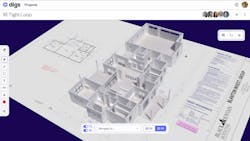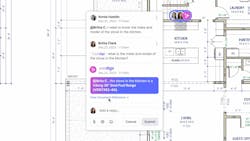Even though my wife and I worked with a top-notch, reputable custom home builder, building our first custom home turned out to be more challenging than expected. Communication was sent through emails, texts, and spreadsheets, making it difficult to keep track of decisions and project progress. When the build was completed, we found ourselves lacking essential information like product details, paint colors, and warranty information. With 15 years of experience in software and AI development, I recognized opportunities to address these pain points effectively.
Teaming up with Ty Frackiewicz, a former luxury home builder and co-founder of Digs, we shared our mutual experiences and identified common challenges faced by builders and homeowners alike. Through extensive interviews with industry professionals, we pinpointed three key areas where AI could revolutionize the construction process: collaboration, data management, and home visualization.
Working within existing collaboration processes
Digital, easy user experiences have remade many categories and is increasingly becoming a consumer expectation. Given that few things in life are as expensive or complicated as a new home-build, it's no wonder this is a sector in which technology aiding clear collaboration, leveraging AI behind the scenes, adds a tremendous amount of value and peace of mind.
Managing a construction project is highly complex, with a lot of moving pieces, and the fear of adding more complexity has led many build companies to accept subpar communication processes. The time spent searching for information across notebooks, emails, and text messages is deemed an acceptable sunk cost due to the lack of alternatives. Integrating AI into communication channels streamlines conversations, allowing teams to focus on relationship-building and the client experience instead of searching for the latest decisions. Digs enhances existing processes by consolidating collaboration through one platform, integrating familiar channels like email or Dropbox. AI is then applied to understand and organize collaboration, decisions, and information within the project, improving overall efficiency and becoming the source of truth.
Due to our focus on ease-of-use, Digs is already being adopted nationwide and is being used by thousands of build professionals in all 50 states and Canada. We have begun to rollout with a handful of top 100 builders and custom builders alike.
One example is MassaRossa, a custom home builder in Oklahoma, who is securing new clients because of their elevated experience with Digs. By utilizing Digs in pre-sales and preconstruction phases, clients can save and organize their ideas and share them with their build teams in real time. The accessibility Digs offers by saving everything in one platform ensures that the architect and interior design teams are well-informed about clients' preferences even before the initial meeting.
Another builder located in the PNW, Cascade West Development, has been using Digs for pre-construction, design, and handoff and warranty management for their two new communities of 84 homes. They onboarded more than one-hundred (100) build professionals, including all of their contractors and vendors. They have been winning more jobs because of the modern digital experience Digs enables throughout the end-to-end build process.
Elevated client experience using AI
Consolidating information into one platform where clients and teams can collaborate together not only creates an elevated experience but also helps create a rich digital twin of the home being built. DigsAI leverages this data to generate custom models that are adept at answering natural language questions about your home build creating a personalized experience. For instance, as a homeowner, I can ask “What is the paint color of my bedroom #3?” or “What are the dimensions, make and model of my kitchen sink?” which are then answered succinctly, without needing to contact the builder or sift through the entire documentation. We achieve this through the latest techniques in Retrieval Augmented Generation (RAG) powered by vector embeddings generated from our custom models. (Said more plainly, it’s like ChatGPT for your personal home data, without losing the privacy of your data; we take extra care that no data ever leaves our platform without the homeowner’s explicit permission). The questions are not only succinctly answered, but the exact document from which it was answered is also referenced and linked giving the user the confidence in the response. This not only reduces the confusion and errors during construction but also provides homeowners with a sense of security and knowledge of their home post-handover.
Visualization of 2D floor plans, in 3D
Digs is creating simple-to-use technology by focusing and solving real-world problems specifically for construction. An example of this is our patent pending technology that takes a normal 2D PDF floor plan and generates a 3D dollhouse without human intervention. We do this by leveraging computer vision and machine learning that not only recognizes every wall, window, door, room dimensions, and appliances but also generates a spatial 3D representation of the plan. This is then interwoven with all the documentation including selections, inventory, change orders, and design layers, to create a true digital twin (semantic understanding) of the home within a few seconds. Digs is making digital twins scalable and affordable for the first time ever by hiding all this technology complexity in the background and providing an easy to use, seamless experience. And the best part is no one needs to enter any additional information, DigsAI runs in the background and creates the digital twin automatically.
Digs isn't just the first to offer a scalable and cost-efficient digital twin solution—it's also poised to drive the adoption of this technology by connecting it back to practical use cases. Homeowners and builders can utilize the information from the digital twin to provide better warranty support, care for and maintain the home better, and track the maintenance and value-add home projects digitally. Thus, when it comes time one day to inevitably sell the home, Digs will have a complete digital record (a CarFax for the home, e.g. home fax), warranting a higher resale value.
While scaling to over 5,000+ homes in under a year, it's been clearly validated that residential construction companies are looking for ways to streamline their software use, provide better client experiences, and create stickier relationships with their clients beyond the traditional home handoff. This new way to visualize homes in 3D and recall information instantaneously using AI will empower build professionals to provide more efficient internal and external collaboration while reducing cost and creating customers for life. Once you have all those connections, it opens up all new types of recurring revenue opportunities for the life of the home.
Is it the time to invest in AI now? Well, I’ll leave you with a quote from one of the build professional industry's leading advocates, “Some smart company out there is going to use AI to completely transform the process of building and buying a new home,” said Rowe. “I think that company is Digs. Their product is changing the way builders and homeowners communicate, and that’s changing the industry.” - Mike Rowe
By Ryan Fink
Digs is Ryan's 3rd time founding a technology startup. Prior, Ryan founded 2x companies with 2x Exits. He was the CEO/Co-founder of Streem (Acq. 2019), CEO/Co-founder of OTG (Acq. 2015). He was a board member of the DEI council of a public company and he has been recognized by Wired, Forbes, NYT, Fast Company, Frost & Sullivan, Mobile World Congress, and more for his contributions to AR, AI, & innovation. Ryan holds over 30+ patents.





